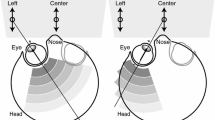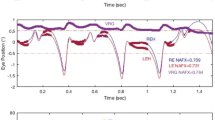Abstract
The analysis of vertical saccades by electrooculography (EOG) is limited by the presence of wave-form artifacts that occur with both upward and down-ward saccades. The artifacts have been shown to increase the calculated velocities of upward saccades. For better evaluation of the nature of these artifacts, voluntary vertical saccades were recorded by EOG and magnetic search coil in five normal subjects and by EOG only in two patients who had previously undergone enucleation. All subjects demonstrated peaked EOG artifacts during vertical saccades. The amplitude of these artifacts was decreased but not completely eliminated by eyelid or eyeball fixation during the attempted saccade. Peak saccadic velocities were also decreased by eyelid fixation, but EOG measurements were generally less accurate than those obtained by search coil. There is evidence that these artifacts may be the result of a combination of eyelid electrical activity and resistance effects.
Similar content being viewed by others
References
Baloh R, Sills A, Kumley W, Honrubia V (1975) Quantitative measurement of saccade amplitude, duration, and velocity. Neurology 25:1065–1070
Baloh R, Langhofer L, Honrubia V, Yee R (1980) On-line analysis of eye movements using a digital computer. Aviat Space Environ Med 51:563–567
Barry W, Melvill-Jones G (1965) Influence of eyelid movement upon electro-oculographic recording of vertical eye movements. Aerospace Med 36:855–858
Bjork A, Kugelberg E (1953) The electrical activity of the muscles of the eye and eyelids in various positions and during movement. Electroencephalogr Clin Neurophysiol 5:595–602
Collewijn H, Van der Mark F, Jansen TC (1975) Precise recording of human eye movement. Vision Res 15:447–450
Evinger C, Shaw M, Peck C, Manning K, Baker R (1984) Blinking and associated eye movements in humans, guinea pigs and rabbits. J Neurophysiol 52:323–339
Ford A (1959) Significance of temporal transients in electrooculographic recordings. Arch Ophthalmol 87:899–906
Gordon G (1951) Observations upon the movements of the eyelids. Br J Ophthalmol 55:339–351
Niida T, Mukuno K, Ishikawa S (1987) Quantitative measurements of upper eyelid movements. Jpn J Ophthalmol 31:255–264
Noboru S, Matsumoto K, Tanaka M, Kashiwaga T, Kaneko Z (1967) Electromyographic investigation of the facial muscles. Electromyography 7:77–96
Robinson D (1963) A method of measuring eye movements using a scleral search coil in a magnetic field. IEEE Trans Biomed Electr 10:137–145
Yee R, Schiller V, Lim V, Baloh F, Baloh R, Hunrubia V (1985) Velocities of vertical saccades with different eye movement recording methods. Invest Ophthalmol Vis Sci 26:938–944
Author information
Authors and Affiliations
Additional information
This work was supported by an Unrestricted Development Grant from Research to Prevent Blindness, New York City, NY
Offprint requests to: D. Yee
Rights and permissions
About this article
Cite this article
Chioran, G.M., Yee, R.D. Analysis of electro-oculographic artifact during vertical saccadic eye movements. Graefe's Arch Clin Exp Ophthalmol 229, 237–241 (1991). https://doi.org/10.1007/BF00167875
Received:
Accepted:
Issue Date:
DOI: https://doi.org/10.1007/BF00167875




